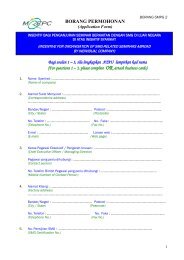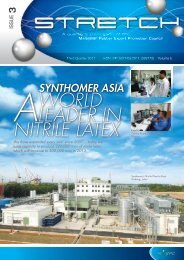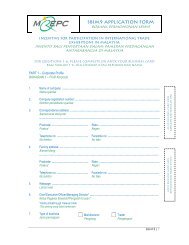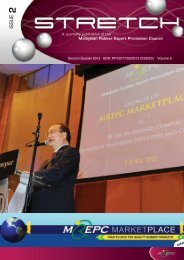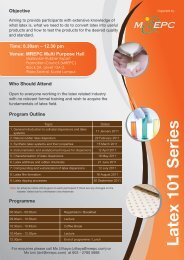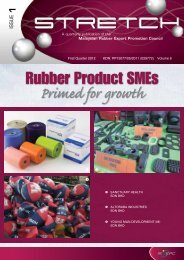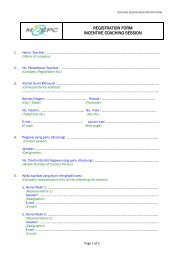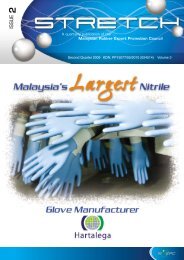Latex Allergy - The Australian experience - LatexGlove.Info
Latex Allergy - The Australian experience - LatexGlove.Info
Latex Allergy - The Australian experience - LatexGlove.Info
You also want an ePaper? Increase the reach of your titles
YUMPU automatically turns print PDFs into web optimized ePapers that Google loves.
<strong>Latex</strong> <strong>Allergy</strong> - the <strong>Australian</strong><strong>experience</strong>Where are we nowProf CH KatelarisUniversity of Western Sydney andCampbelltown Hospital<strong>Latex</strong> conf Dec
<strong>Latex</strong> <strong>Allergy</strong> -<strong>Australian</strong> ExperienceClinical studies -dental workers- nurses- spina bifida- operating room staff- 1st respondersPolicy developmentEvaluation of strategy effectiveness
<strong>Latex</strong> <strong>Allergy</strong> - Westmead Dental StudyKatelaris et al, 1996 Questionnaire survey of Westmead Dental School 177/230 staff members (77%) responded Detailed questions on:-hand dermatitis-symptoms of latex allergy-general allergic history
<strong>Latex</strong> <strong>Allergy</strong> - Westmead Dental StudyKatelaris et al, 199633% -symptoms with glove use22% - glove dermatitis9% - latex allergy
Symptoms reported by subjects withquestionnaire based latex allergycompared to all other subjects<strong>Latex</strong> Allergic Non-latex allergic___________ ___________ ___________ ___________ ___________n % n %glovedermatitis 15 94% 24 15%(p=.02)Othercontactdermatitis 5 31% 27 17%Food allergy 3 19% 18 11.1%Animal 4 25% 25 15%allergy___________ ___________ ___________ ___________ ___________Total 16 161___________ ___________ ___________ ___________ ___________
Action taken by latex allergic subjects37% - Nil31% - Seen by GP6% - Seen by specialist25% - Changed glove brand50% - Treated with medication(handcream,antihistamine)
Minimising the risks of latex allergy:<strong>The</strong> effectiveness of written information.FM Carrozzi RN , + CH Katelaris MB BS PhD FRACP, + TV Burke RN, + and RP WidmerMDSc, FRACDS,* Institute of Immunology and <strong>Allergy</strong> Research, Westmead Hospital,+and Westmead Centre for Oral Health* Westmead, Sydney, Australia.Aust Dental Journal 2002
<strong>Latex</strong> <strong>Allergy</strong> - Hobart ADA StudyCH Katelaris, RP Widmer, R Lazarus, B Baldo494 Questionnaires464 Questionnaires and Skin Testing
<strong>Latex</strong> <strong>Allergy</strong> - Hobart StudyQuestionnaire based glove dermatitisn= 79 ( 16%)Questionnaire- based latex allergyn = 40 (8.6%)
<strong>Latex</strong> <strong>Allergy</strong> - Hobart StudyGlove-related symptoms151 ( 31.5%) had problems with gloves% subjects with problemsItch 73Redness 67Hives 33Other rash 36Longterm hand problems 44
<strong>Latex</strong> <strong>Allergy</strong> - Hobart StudyAction taken for symptoms% subjects with problemsnil 66GP consultation 28Specialist cons. 11glove change 43use medication 51hand cream 32cotton gloves 15
<strong>Latex</strong> <strong>Allergy</strong> - Hobart Studyextract number of subjects n=464 (%)wheal diameter (mm)0 1-2 3-5 >5glove 440 18 5 1extract (94.85) (4%) (1%) (0.2%)ammoniatedlatex 404 48 5 7(87%) (10%) (1%) (2%)(Positive SPT either extract in 12 patients -2.6%)
<strong>Latex</strong> <strong>Allergy</strong> - Hobart StudyComparison of Skin Test to QuestionnaireSensitivity - 7/12 (58.3%)Specificity - 420/452 (94%)Negative predictive value - 98.8%Positive predictive value - 18%
Comparison of Westmead, Hobart andPerth Questionnaire DataWestmeadn=177Hobartn=494Perthn=510Gloverelatedsymptoms52(29%)151(31.5%)166(32.7%)QBLH 16 (9%)40 (8%) 60 (11.8%)QBGD 39 (22%)79 (16%) 9 8 (19.2%)
1997Douglas R. Morton J. Czarny D. O'Hehir RE.Alfred Hospital, PO Box 815, Prahran, Vic. 3181; Australia.Prevalence of IgE-mediated allergy to latex in hospital nursing staff.<strong>Australian</strong> & New Zealand Journal of Medicine. Vol. 27(2)(pp 165-169), 1997.AbstractBackground: IgE-mediated hypersensitivity to latex proteins has become a significant clinicalproblem over the last decade. Nursing and medical staff are at risk because of their occupationalexposure to latex. Aims: To determine the prevalence of type I hypersensitivity to latex allergensin the nursing staff of an <strong>Australian</strong> hospital. Methods: A questionnaire which asked aboutsymptoms associated with the use of latex gloves was completed by 140 nurses working in theAlfred Hospital (72 in general medical wards, 68 in intensive care units). Skin prick tests witheluates of five different types of latex glove as well as common aeroallergens (rye pollen andhouse dust mite) and banana extract were performed. Results: Thirty-one nurses (22%) wereskin prick test positive to at least one of the five latex glove eluates. All of these nurses wereatopic, having positive skin prick tests to rye pollen or house dust mite. Symptoms of localdryness, itch and erythema associated with glove use were reported by more than half the studygroup, but not more frequently by those who were skin prick test positive to latex. Urticariaassociated with glove use was reported more frequently by those with positive latex skin pricktests (13% vs 4%, p=0.05). Eighty-seven per cent of the nurses who were latex skin test positivewere also positive to banana extract. Conclusions: IgE-mediated hypersensitivity to latex iscommon in nurses working in an <strong>Australian</strong> hospital. Glove associated symptoms werefrequently reported, but in most cases the symptoms were more typical of irritant or contactdermatitis rather than type I hypersensitivity reactions. However, the extent of subclinicalsensitisation to latex found in this study suggests that symptomatic latex allergy is likely toemerge as an increasing problem for nursing staff in this country.
<strong>Latex</strong> <strong>Allergy</strong>-Nurses StudyDouglas et al 1997140 nurses - questionnaire and skin tests 22% skin test positive to at least 1of 5 “in house” latex extracts <strong>Latex</strong> SPT positive:-atopic - 56% allergic rhinitis28% asthmaAll skin test positive to an aeroallergen-87% positive to banana skin test(only one had symptoms) No difference with age, years worked, glove changes
<strong>Latex</strong> <strong>Allergy</strong> -First RespondersBridgewater, Katelaris et al,1998 Questionnaire surveySt John Ambulance -SA,WAAmbulance Service -SA 1,099 / 2,716 forms returned (40.5%) Results:hand dermatitis 9.37%latex allergy 6.37%atopy 14.9%
<strong>Latex</strong> <strong>Allergy</strong> - Spina Bifida StudyValentine et al, 1999104 spina bifida patients and 50 siblingsQuestionnaire and specific IgE
<strong>Latex</strong> <strong>Allergy</strong> - Spina Bifida StudyValentine et al, 1999La tex PositivehistorySpecific IgESpina bifida 15.4% 36.9%siblings 0% 15.4%
<strong>Latex</strong> <strong>Allergy</strong> in OT StaffME Hack. Anaesth Intensive Care 2001Operating suite in city hospital 102 Surgeons, nurses and wardsmenQuestionnaire and RASTs to latexOperating suite had been powder -free for18 months
<strong>Latex</strong> <strong>Allergy</strong> in OT StaffME Hack. Anaesth Intensive Care 200132/102 had hand problems with gloves20/102 <strong>experience</strong>d symptoms in OTOne subject (non-atopic) - systemic symptomsand 3+ RAST
<strong>Latex</strong> <strong>Allergy</strong> in OT StaffME Hack. Anaesth Intensive Care 2001BUT-Selection biasSanofi RAST used - non standardisedFacility had been powder free for >18 months4% of population stated occurrence of previousanaphylaxis4 subjects declared allergy to known crossreactive fruits
2004
<strong>Latex</strong> <strong>Allergy</strong> at Freemantle HospitalGraumuller et al, Allergologie 2004 281 HCWs -questionnaire- SPT with ALK extract- specific IgE ELISA-allergopharma Results-SPT positive in 3.9%- ELISA positive in 3.9%- questionnaire positive in 5.3%- overall latex allergy in 3.6% (higher rate in atopics)
<strong>Latex</strong> <strong>Allergy</strong> -prevalenceGeneral population 1%General atopic population 1%-9%
<strong>Latex</strong> <strong>Allergy</strong> -prevalenceOccupational exposureHealth care workers 3-17%Rubber industry workers 5-10%Approximately half with positive SPT will havesymptoms2%-10% prevalence of occupational asthma
<strong>Latex</strong> <strong>Allergy</strong>-prevalenceSpina bifida10-68%Children with early and frequent exposure -SPT positive in > 25% with more chance ofclinical reactionsIf little exposure history - much reduced rate ofsensitisationNRL sensitisation is very uncommon in generalpaediatric population
<strong>Latex</strong> <strong>Allergy</strong>- Risk FactorsLevel of exposureRoute of exposureAtopy-this association strong in <strong>Australian</strong> studiesCertain food allergies-Melbourne study showed high degree of SPT positivityto banana but clinical reactivity rare in that studyHand dermatitis- our dental studies have shown this to be a powerful riskfactor -almost all dental workers with symptoms of latex allergyhad hand dermatitis preceding their symptoms
POLICYASCIA GuidelinesArea Health Service GuidelinesNSW Dept of Health Policy
ASCIA Guidelines Subcommittee first edition 1996 revision 1998
GUIDELINES FOR THE MANAGEMENT OF LATEX-ALLERGICINDIVIDUALS IN HEALTH CARE FACILITIES AND FOR THEMINIMISATION OF CONTINUING LATEX SENSITISATIONThis document has been prepared by a Working Party of <strong>The</strong> Australasian Societyof Clinical Immunology and <strong>Allergy</strong> (1996)ConvenorConnie KatelarisMBBS PhD FRACPSenior ConsultantClinical Immunology and <strong>Allergy</strong>Westmead HospitalWestmead NSW 2145Working Party Members Helen Kolawole, FANZCASpecialist AnaesthetistPeninsula Health Care NetworkDepartment of AnaesthesiaPO Box 52Frankston VIC 3199Richard Widmer, MDSC FRACDSAssociate Professor, Paediatric DentistryWestmead HospitalWestmead NSW 2145Janice Labbett, RN, Grad. Dip. ManagementSenior Nurse ManagerOperating SuiteWestmead HospitalWestmead NSW 2145
<strong>Latex</strong> <strong>Allergy</strong>-ASCIA GuidelinesPublic Health Issues universal adoption of powder - free gloves low - allergen containing gloves good hand washing and hand - care techniques specific information available to “at risk” individuals
Guidelines<strong>Latex</strong> <strong>Allergy</strong> Guidelines for Hospital Management of <strong>Latex</strong> AllergicPatients including Operating Suite Guidelines Guidelines for General Practice Management of <strong>Latex</strong>Allergic Patients Guidelines to Promote Safe Practice in the DentalEnvironment for <strong>Latex</strong> Allergic Patients <strong>Latex</strong> free List Advice for <strong>Latex</strong> Allergic Individuals
Nearly all sensitised health care workerscan continue working with theappropriate environmental modificationwhich is feasible and effective.
1st met Nov 1997<strong>Latex</strong> <strong>Allergy</strong> -NSW Health Department Final policy released Dec2000 (Jan 2001)!!!
<strong>Latex</strong> <strong>Allergy</strong>-health dept document Introduction Policy Economic considerations Consultation Implementation Health care employees -prevention, earlyidentification, management Health consumers -identification andmanagement of latex allergy Emergency procedures Documentation <strong>Info</strong>rmation and training Evaluation of programmeeffectiveness References Appendices
<strong>Latex</strong> <strong>Allergy</strong>-Health care employees - prevention, early identification,management:Each Health Service shall:“Develop strategies for the prevention of latex allergy in health care workers,early identification where it does occur and its effective management.Prevention strategies are to include the change to powder free latexgloves.”
<strong>Latex</strong> <strong>Allergy</strong>Health consumers - identification andmanagement of latex allergyEach Health Service is to:Include strategies for the identification andeffective management of latex allergic healthconsumers in the various clinical settings
<strong>Latex</strong> <strong>Allergy</strong> - Policy FormulationNSW Health Department Record Keeping Evaluation Implementation strategies <strong>Info</strong>rmation, recommendation for manufacturers,suppliers
<strong>Latex</strong> <strong>Allergy</strong>-DocumentationEach Health Service shall:Generate and manage appropriatedocumentation systems for each aspect ofthe policy
<strong>Latex</strong> allergy preventionHave policies been successful?Some overseas studies<strong>Australian</strong> <strong>experience</strong> - indirect evidence
<strong>Latex</strong> allergy - progress sincepreventative measures adoptedLab requestsClinical presentationsPerioperative anaphylaxis dataRestudied Westmead Dental school
<strong>Latex</strong> <strong>Allergy</strong> - 20 years on….Has the epidemic come and gone?Mechanisms of sensitisation well understoodMuch is known about the allergens at amolecular levelRole for immunotherapy under investigationBUTNatural history of latex allergy is still not clearNeed to assess prevention/avoidance strategiesand their efficacy in AustraliaNeed revision of health dept policy in line withadvances in manufacturing



